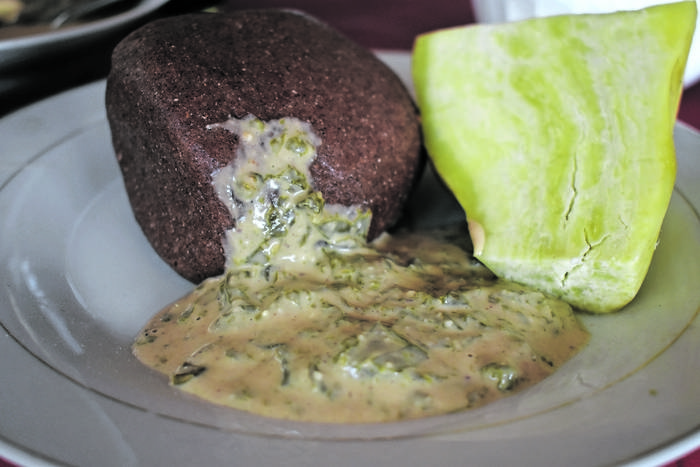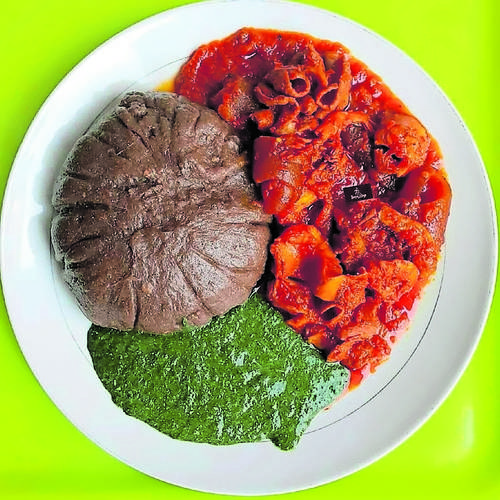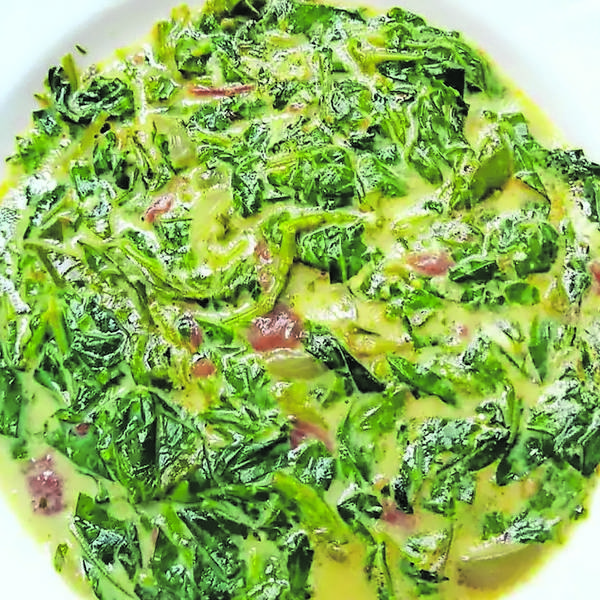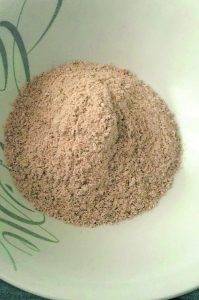Granat soup from Sierra Leone
Rainy day soul food
Sierra Leone: Granat soup
I can conjure the aroma and sweet taste of a delicately prepared groundnut soup even from a distance. Its oily, smooth and creamy appearance makes it irresistible. The craving for it is more appealing on a wet evening because the spices used to prepare are a comfort against cold. When cooked with the right amount of hot pepper, you will be sweating by the time you finish a small bowl.
The nuts, grown and sold all over Sierra Leone, are ground thoroughly until they become like peanut butter. This paste is boiled before adding hot pepper, fish, meat or chicken. It can be cooked with palm oil or olive oil, and vegetables such as onions and tomatoes, garden eggs, bitter balls and one or two stock cubes.
Groundnut soup, or granat soup, as it is locally called, is also popular in other West African countries like Ghana, Nigeria, Senegal, Gambia, Guinea and Liberia. International tourists go for a taste and it often becomes their favourite.
People serve groundnut soup with meat or fish alongside boiled rice during traditional festivities such as weddings or the naming of a child. — Abdul Brima
Like a warm hug
Uganda: Boo
I always say, two of the best things about living in Uganda are the food and the weather. On any given day, you can walk into a restaurant, ask for food and have a rainbow of posho (maize), matooke (banana), yams, sweet potatoes (yellow or creamish in colour), kalo (millet bread) and pumpkin — and that doesn’t even cover half of it.
Tying all this wonderful food together are the sauces. I love boo sauce, pronounced “boe”, because it is something I cannot make at home. I do not know how and I do not care to learn. Eating it is self-care and you wouldn’t want to give yourself a massage would you? It is a treat.
Boo is not for you if you want a sweet meal. If you are looking for a light snack on the go, you’re better off trying something else. If what you want is a thick sauce that has vegetables, a heavy mouth feel and one that will fill you up, then this sauce from northern Uganda might just be what you need.
Boo is made from groundnut paste, gobe (bean leaves), cowpea leaves and otigo (okra) greens and can be eaten as a side or as the main sauce. As with any dish, recipes vary. Because it is somewhat of a speciality dish, it used to be hard to find boo in Kampala’s restaurants. Luckily this has changed.
When it comes to the taste, I have found boo to often be smoky and slightly tart. That tell-tale sweetness you’d expect from the groundnuts is muted by the gobe greens. That slightly bitter taste at the end, in the way that dark chocolate is slightly bitter, that’s the otigo (jute mallow).
I often associate food with feelings. Chips for when I’m feeling light, katogo for when I miss home. Boo? It is the sort of meal that makes me feel like I’m being given a warm hug. — Anna Kirya
 Boo from Uganda
Boo from Uganda
Savour all the flavours
Kenya: Mrenda
Like most Kenyan kids living in the city in the 1990s, every December holiday we would go to our home village. The highlight of this trip was watching my grandmother, Kadenge, prepare mrenda from jute mallow leaves. When the dish was ready, we would have our own candle-lit dinner by the light of the homemade koroboi lamp, because there was no electricity, or, if we were lucky, we would eat outside under the moonlight.
To this day, whenever I eat or prepare mrenda, I think of Kadenge. She wasn’t just feeding us, she was instilling a love of food and family that endures even in her absence.
Mrenda is so delicious. The leafy green delicacy is eaten mostly by the Luhya of western Kenya, where it is also called mtere and murere. In the Yoruba parts of Nigeria, it’s known as ewedu. When cooked, it has a slippery texture that makes it easy to swallow and savour all its flavours.
I can only make it Kadenge’s way. Add water to a large pan along with two tablespoons of musherekha, a traditional salt that is used as a tenderiser. When the water boils, add the mrenda and it will start bubbling. Keep stirring until it becomes dark green, then remove from the heat and drain excess water. In the same pan, fry some onions in oil. The mrenda goes back in when the onions are soft, along with salt to taste. Serve it hot with ugali (maize).
What sets mrenda apart is its simplicity (and the musherekha that enhances the flavours). When I became a mother, I knew that it would be part of our family’s menu too, and we have it every Monday with ugali. My son loves it — and I love that he loves it. Each bit is a celebration of the universal language of food — and of my grandmother. — Daisy Chukunzira
 Mrenda from Kenya
Mrenda from Kenya
A dish that makes me smile
Lesotho: Lipabi
Lesotho has a range of traditional foods, which makes Sesotho dishes unique. Lipabi, a powder ground from roasted maize, is a staple food of Basotho. Most dishes of Basotho people can be traced back to the founder of the Basotho nation, Morena (King) Moshoeshoe I, who is still celebrated today.
Lipabi is mostly used as a dish for traditional purposes and as a provision for journeys because it can stay fresh for long periods of time. Every year people gather at Thaba-Bosiu to prepare different kinds of traditional food to celebrate and honour the founder of Basotho.
Growing up in the rural areas of Lesotho in the early 1990s, I remember waking up before dawn, the sound of my grandmother’s voice gently nudging me out of bed. As the sun slowly crept over the horizon, her loving hands prepared lipabi for people who had come for letsema (to work together in a group). While she cooked, she shared life lessons with me, her words as nourishing as the food she made. This is how it became my favourite food.
Lipabi is prepared using ground maize called khoahla, which is a winter selection of maize. It is dried and roasted until fully cooked then crushed into a very fine powder using a stone hand mill. Afterwards you add a pinch of salt and sugar for taste and mix it well. It can also be mixed with water.
Looking back, I realise that my grandmother’s insistence on teaching me how to make lipabi was more than just a culinary lesson. It was a lesson in perseverance, in learning a skill with patience and determination. It taught me the value of hard work and the importance of passing down traditions from one generation to the next. I still smile today when I prepare lipabi. — Angela Ts’iame
 Lipabi from Lesotho
Lipabi from Lesotho
Falling in love with amala again
 Amala from Nigeria
Amala from Nigeria
Nigeria: Amala
My mother says amala, the starchy meal that my people make from yam flour, was the first solid food I voraciously took to after I was weaned. In my early teens, however, I wouldn’t let anyone outside my family know I loved amala. I avoided it at parties even when I really wanted it. My reason? My mates considered amala “local” and therefore uncool.
I remember a family reunion in my hometown. I expected rice and chicken, but was greeted with hot amala and gbegiri, a soup we make from black-eyed beans. It was only fitting; I’m from Oyo State in Nigeria and we love amala. I decided to eat, only for these cousins of mine to complain about how amala wasn’t cool, and then I changed my mind. (We all ate it in the end though).
I enjoy eating amala with abula, which is a mixture of gbegiri (beans) and ewedu, a leafy vegetable with the texture of okra. Making amala is straightforward: simply pour yam flour in hot water, stir well until smooth, and let it cook for a couple of minutes.
Entering university revived my love for amala. Classes, assignments and extracurriculars took so much time, I made the same meals which became tiring in no time. I wanted something different and one day I asked a friend to follow me to an amala spot not far from our faculty building.
While some use cutlery, I prefer eating amala with my hands. There’s something about feeling the smooth morsel on your fingers and dipping it in soup.
I dragged my friend because I hoped a familiar face would make me feel less self-conscious and awkward. I shouldn’t have worried. The way people ate showed the love they had for their meal and it rubbed off on me. There, I fell in love with amala all over again.
“Amala dates” became a thing for me. A bad test? Eat amala to deal with the pain. Planned a great event? Eat amala to celebrate. I’ve made friends over a shared love of the meal and I’ve come to appreciate my culture even more because of this meal. — Adebisi Amori